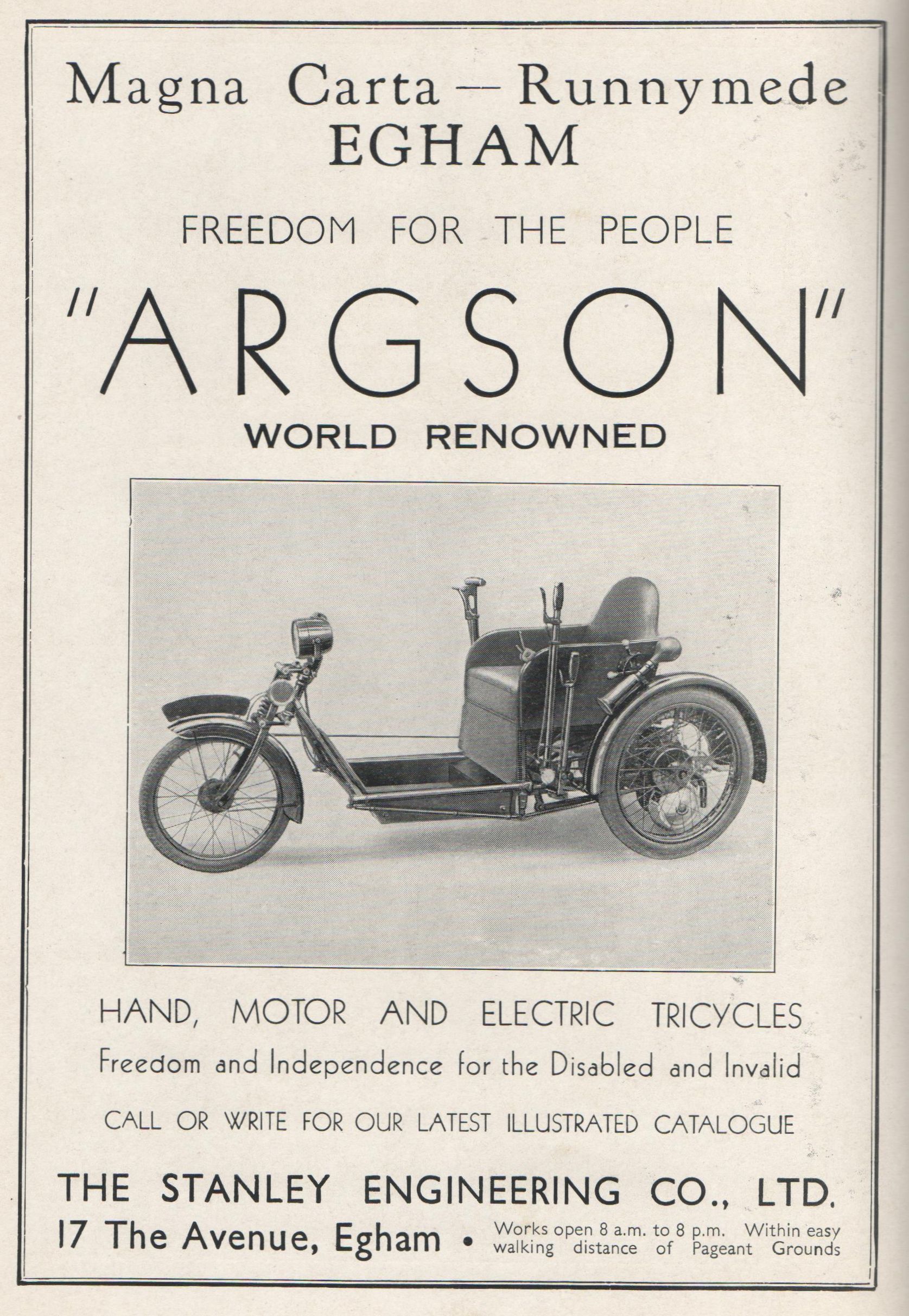The enigmatic history of an Argson and the Stanley Engineering Company
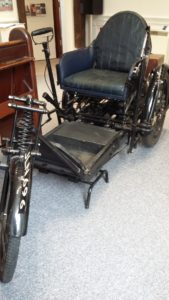
Among the exhibits of particular interest on permanent display in Egham Museum is a three wheeled motorised invalid carriage, known under the model name of Argson Victory and the registration number JLN 696.
It was manufactured in Egham probably in 1946/7 by the Stanley Engineering Co. Ltd, which had a very large factory in 17 The Avenue, and was in Great Britain, at the time, the biggest manu-facturer of transport for disabled and invalid people.
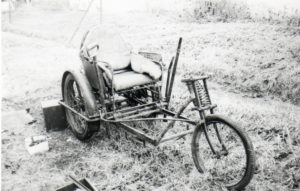
In 2001 John Mills, the Honorary Curator of Egham Museum, meeting Lawrence Collins, a former schoolmate from Shepperton Rotarians and speaking with him of his various activities, stated that the vehicle was acquired by the Museum in 1990 and stored in the museum loft, completely dismantled and with many parts missing. [1]
Lawrence and two fellow Shepperton Rotarians, Bob and Ken, showed interest in this historical artefact and expressed the willingness to restore it even though there were no drawings. They started to work hard and, in the summer of 2003, after about 18 months, completed to assembly and rebuild the invalid carriage.
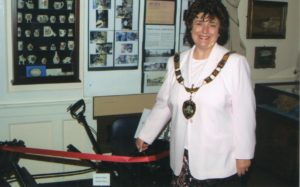 It was officially handed over to the Museum by the local Mayor Mary Angell.
It was officially handed over to the Museum by the local Mayor Mary Angell.
JLN 696 is a precious exhibit but its history is a mystery, because certain information is very scarce, vague, or full of gaps, and therefore, it is difficult to trace its full ownership.
Its importance is connected to the development of a large market of vehicles intended for use by people who had lost limbs following the First and Second World Wars. This specialised mobility production spanned in the UK from 1864 until 2000 and gave the origin to the Stanley Engineering Company that introduced the industry’s first purpose-built motor tricycles.
Founded in June 1919, it was named Argson Engineering Company [2], from the initials of the two founders, both engineers [5] Arnold Ramsden Garnett and Stanley Orton Needham [10]. Arnold Ramsden Garnett was an invalid without the use of his legs, and Stanley Orton Needham was a designer trained by Rolls Royce. The company was based originally in the West End of London [3] and afterwards in Twickenham [4]. It was the outcome of collaboration of two engineers,
They produced hand-propelled tricycles, the highest value on the market, and in 1921, an adapted light motor tricycle, with one single front wheel and the other two fastened to a common rear axle, driven by the company’s own Beaufort 170 cc engine. In 1926 Needham was appointed Works Manager, renamed the company Stanley Engineering Company, and moved to Egham.
The company grew fast especially following the introduction in 1948 of the Ministry of Health’s National Health Service and the Invalid Vehicle Service, when both powered and hand-propelled forms of the invalid three wheelers were issued free of charge to any disabled person meeting the requirements.
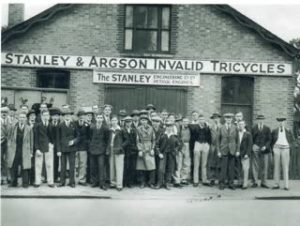
The Stanley Engineering received orders from H. M. Government, the British Red Cross and other societies and began to manufacture a large number of carriages. They extended their Works with shops housing upwards of 80 machine tools and gave constant all the year-round employment to 140 men and boys .
In 1954 the business was acquired by Harper Engineering with its own brand, and moved to Exeter Airport, Devon, where in 1971 went out of the market.
One of the employees, Mr. Hewerdine, opened up his own company in 1947, in Devil’s Lane, Egham. Today the business is named Mobility for You and is the major supplier of wheelchairs, powerchairs, rehab buggies and accessories.
The success of brand Argson was testified by lots of users and detailed in the following:
POINTS that make the “ARGSON” the Masterpiece of Invalid Tricycle Construction
Low Centre of Gravity; Straight Frame Members; One – piece Head Bracket; Perfectly Sprung Seat; Long and Dust-proof Bearings for Propelling Levers; Dust-proof Ball Bearings on both ends of connecting Rods; The Combined Variable Speed Gear and Differential axle of simple design and construction with free or fixed wheel at will on the high gear, in addition to the neutral position between the gears, the whole being enclosed in an oil-tight case and running in oil.
Effective Brake Construction, giving perfect safety in both directions; Ease of Control and Steering; Ball Bearings throughout; No exposed working parts;
The “ARGSON” is essentially a no-trouble machine and is the acme of simplicity and accessibility. A boon to invalids who have, perforce, to attend to their own machines, it is only necessary to replenish the oil in the gear box every 2,000 miles, or say, every six months.[6]
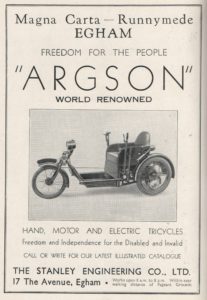
Over a period of 30 years, stunning models were manufactured in hand propelled, electric and petrol forms such as De Luxe, Standard and Runnymede.
JLN 696 is a rare Argson Victory vehicle.
Technically it is a mechanically propelled nvalid carriage, petrol powered, fitted with a 147 c.c. Villiers engines, two-stroke and open-style design. Starting is by a lever on the driver’s right. The petrol tank is mounted centrally behind the seat and has a capacity of 2½ gallons, giving a minimum range, in normal conditions, of 200 miles.
The model Victory was officially produced in 1945 [7] and advertised on the local Staines & Egham News in early 1946.
It was designed to be an inexpensive but reliable vehicle with a few unusual features. The channel frame construction was adopted after numerous road tests and its use lowers the cost of production; the combination of an adjustable seat and adjustable connecting rods enables the standard machine to accommodate users of varying heights.
After the restoration of the invalid carriage, the Drivers Vehicle Licensing Agency, at Swansea [8], told Egham Museum that they have no record of the year of the manufacture, but registration numbers beginning with JLN were issued by London County Council from 1947.
The Motor Car Act 1903 introduced motor vehicle registration, driver licensing and the standard formats for plates. All motor vehicles and motorcycles had to be licensed by their Local County or County Borough Council and were assigned individual registration numbers.
The first registration marks were made up of one letter with one number, the first (A1) being issued by London County Council in 1903.
In 1906 “LN” was one of the London series of marks and it was related to the north west area where the first owner presumably lived.
In the 1930s it was decided to increase the number of index marks allocated to the Councils by issuing new marks based on the addition of a single letter in front of the existing 2-letter marks. The first 3-letter marks were authorised by the Road Vehicles (Index Marks) Regulations 1932 and started to be issued from the end of that year.
In the case of our Argson, the letter J, that preceded the London index mark LN, was introduced in 1947. Unfortunately no records of vehicle registration have survived apart from one that is for the period 1917-19 and is referred to the index mark LT. So it is not possible to know who the first owner was.
All we know is that the first recorded keeper [9] was Norman Cousins of Cookham in 1981. In 1986, Mark Bradshaw of Maidenhead was the registered keeper and sometime before 1990, JLN 696 was purchased at an auction sale in the London region by a gentleman, involved in a motor cycle renovation, who passed it to Mr. Barber of Coventry, also involved with old motor cycles. Trustee of The Egham Museum, Mr. Bairstow, learnt from a Mr. Knight of Bedford that Mr. Barber owned an Argson tricycle which was for sale, and so, the Museum bought it for £100 in 1990.
Another restored Argson Victory completed a run from the Channel to Switzerland in June 2011 [11] , commemorating a similar 1,500 journey undertaken in 1947 by O.A.Denley, founder of the Disabled Driving Association to demonstrate that disability was not necessarily a handicap.
Researched and written by volunteer Loredana Losavio and Peter Binns
[1] Mills, John, Argson Invalid Motorised Tricycle, “Egham-by-Runnymede Historical Society”, Newsletter Nov/Dec. 2001.
[2] British Library, Certificate of Incorporation,18th June 1919, in British Library, Company No:156083; Argson Engineering Company Ltd. Incorporated in 1919. Dissolved between 1919 and 1932.
[3] Id., NOTICE of the Situation of the Registered Office, 16th June 1919, in Ibid.
[4] Id., NOTICE of Change of the Situation of the Registered Office, 23th October 1922, in Ibid.
[5] Id., Particulars Respecting Directors, 26th June 1919, in Ibid.
[6] Surrey History Centre, Stanley Engineering Co Ltd., Egham: Trade Catalogue for “Argson” Invalid Tricyles, 1948.
[7] The Stanley Engineering Company Lt.,The Argson Victory Invalid’s Tricycle, Trade Catalogue, Egham 1945. http://www.veterancycleclublibrary.org.uk/ncl/pics/Stanley%20Engineering%20Argson%20catalogue%201950%20(V-CC%20Library).pdf
[8] Collins, Lawrence, The Story of JLN 696, “Egham-by-Runnimede Historical Society”, Newsletter July/Aug. 2003.
[9] Ibidem.
[10] Grace’s Guide to British Industrial History. (see below).
[11] Daily Telegraph 17 May 2011
Sources of information:
Books
-Cyphus, Stuart, An Introduction to Invalid Carriages, This publication ©Stuart Cyphus, 2006.
-Riden, Philip, How to Trace the History of your Car: Guide to Motor Vehicle Registration Records in Great Britain, Ireland, The Isle of Man, and Channel Islands, Academy Books, 1991.
Collections
-Surrey History Centre, Stanley Engineering Co Ltd., Egham: Trade Catalogue for “Argson” Invalid Tricyles, 1948.
– British Library, Certificate of Incorporation, in British Library, Company No:156083; Argson Engineering Company Ltd. Incorporated in 1919. Dissolved between 1919 and 1932.
–Id., NOTICE of the Situation of the Registered Office, 16 th June 1919, in Ibid.
–Id., NOTICE of Change of the Situation of the Registered Office, 23th October 1922, Ibid.
– Id., Particulars Respecting Directors, 26 th June 1919, in Ibid.
Magazines
-Collins, Lawrence, “HGT RENOVATES ANTIQUE CARRIAGE”, “Historic Gas Times”, Newsletter, Dec 2003.
-Collins, Lawrence, The Story of JLN 696, “Egham-by-Runnimede Historical Society”, Newsletter July/Aug. 2003.
-Mills, John, Argson Invalid Motorised Tricycle, “Egham-by-Runnimede Historical Society”, Newsletter Nov/Dec 2001.
-British Library, “Stanley & Egham News”, Friday, March 29, 1946.
Websites/electronic sources
-Grace’s Guide to British Industrial History.
http://www.gracesguide.co.uk/Main_Page
-DVLA, A brief history of Registration.
http://www.driveall.co.uk/files/4813/6897/5728/inf57.pdf
-The Stanley Engineering Company Ltd, The Argson Victory Invalid’s Tricycle, Trade Catalogue, Egham, 1945.

